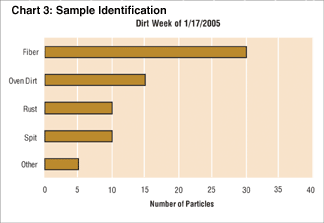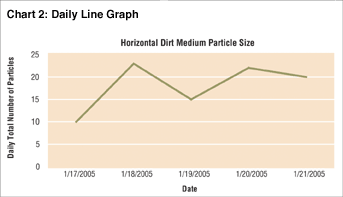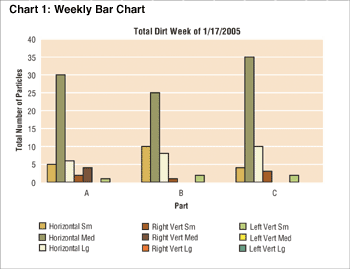Dirt Identification to Elimination
Dirt is a major issue for painters. The identification and removal of paint can only be achieved with the implementation of an extensive - and ongoing - dirt program...
Dirt. Everybody has it, nobody wants it. Small shops with two people up to large shops with 100 people have dirt in their coatings. With an infinite number of sources and a variety of shapes and sizes, dirt in paint is hard to control and nearly impossible to eliminate. Pristine clean paint areas or clean rooms help but do not provide immunity from dirt. Controlling and/or eliminating dirt can only be accomplished through a comprehensive dirt program. Spraying and praying or if you are proactive, praying then spraying is not considered a comprehensive dirt program. I am surprised at the number of shops that practice this or similar methods and wonder why nothing changes.
There are many methods or methodologies that can be used for dirt reduction. Some work better than others. The proven methods, ones that work every time and at different shops, look at the overall dirt picture and define the impact that dirt has on production. Shops that purchase a microscope, randomly look at dirt particles, determine the source and eliminate that source usually do not have a significant impact on dirt reduction. Understanding the amount of dirt particles you have, the source or sources of these particles and the impact on production is the key to a successful dirt program. The comprehensive dirt program that I use is comprised of the following seven steps:
- Define what is dirt.
- Determine the number and the location of dirt particles on the parts.
- Determine the effect dirt has on production and the associated costs.
- Identifying the source or sources of the dirt.
- Developing methods of elimination.
- Implementation of the best elimination method or methods.
- Track the results and maintain changes.
Successful dirt programs are usually comprised of these or similar steps. This program is a lot of work and takes a concerted effort to start, run and get results. But it is worth all the effort. I have used this program for 15 years with great success.
The first step, define what is dirt, seems very simple and straightforward. Do not overlook this step - it is one of the most important. Not defining what dirt is or incorrectly defining it will spell doom from the beginning. Shops make the assumption that every particle on the surface should be considered dirt. Some go to the extreme of using cellophane to rub on the surface and accentuate particles. There are some finishes that require this level of cleanliness but most do not. Shops just starting a dirt program can become overwhelmed quickly if every particle is considered dirt.
The best way to start defining dirt is to review what your customers are rejecting and what is creating parts to be reworked in-house. Size of a dirt particle is usually the best way to define dirt. Compare the particle size of dirt on the rejected pieces versus the pieces that are not rejected. There will be dirt on the pieces that are not rejected. The smallest particle on the rejected piece that is larger than the particles on the not rejected piece is the starting point.
A dirt definition or an unacceptable particle size is only useful if it can be accurately repeated in dirt counts. Visual sizing or assessment is usually not accurate or repeatable. A template with various particle sizes is the best way to ensure accurate repeatability. I use a credit card size piece of plastic with holes of various sizes drilled in it. The hole sizes range from smaller to larger than the unacceptable particle size. Different hole sizes are needed to help divide dirt into size categories. When dirt counts are done, the particles need to be grouped into different sizes. The group with the largest number of particles is the first ones that will be identified.
Determining the number and location of dirt particles on the parts, the second step, is just a glorified way of saying dirt counts. The purpose of this step is to figure out the how much dirt you have and where it is. The counts need to be done consistently–shift to shift, day to day. The best consistency is achieved if the same person on each shift does the counts each day. The counts need to be done on the part or parts that make up the majority of production. The counts need to represent production as a whole. You cannot count dirt or sample dirt only on parts that have been rejected and expect long term effects. Limiting counts to reject parts will only show part of the picture. There are many factors that affect dirt. A quantitative analysis of all the dirt is necessary to understand the whole picture. The counts have to be done on at least 20 pieces of each part per shift to be statistically valid. Initially, the counts need to be divided into location and size. The best way to accomplish this is by using a tally sheet. An example of a tally sheet is illustrated in Table 1. This tally sheet is a general example. The tally sheet should be tailored to your shop and parts.
The counts for each part are totaled by location and size and used to create a bar chart. The bar chart is a visual representation of the data. A bar chart for one week is illustrated in Chart 1. The charts can be created daily but weekly gives a better overall view. The location and size with the largest count will be charted daily on a line graph to track day to day variances. A daily line graph is illustrated in Chart 2.
 |
| Bug |
 |
| Feather |
 |
| Feather |
 |
| Fiber |
The impact of dirt can be felt in many ways by a shop—lost production, repainting of parts and dissatisfied customers to name of few. But the bottom line is what is dirt costing you. The easiest way to estimate the overall impact of dirt is to identify what amount of production, in percentage, is lost. Total up the number of parts repainted, scrapped and returned for dirt defects. Make sure the count for repainted parts are accurate. Most shops under-estimate the number of repaints. Shops can have a different process for repaints, this alone indicates there is a problem. Determine what percentage of production these parts represent. Multiply the percentage of the parts by annual revenue. This figure is what dirt is costing you. The parts that are repainted, scrapped and rejected are lost business, just like if a customer switched shops. These parts accounted for production that could have went to other parts.
Identifying the source or sources of the dirt, step 4, will require equipment to be complete. The
basic equipment needed is a scalpel, tweezers, microscope slides, microscope slide storage box and a microscope.
The first step to identifying the source of the dirt is to sample the dirt that is on the parts. The samples of dirt from the parts will be compared to samples of dirt collected from around the shop. The location on the part with the highest number of dirt particles, refer to chart 1, is where the dirt samples are taken. Sample only the particles that are the same size as the one with highest counts.
Obtain as many samples as possible over a week period. A greater number of samples will better represent what is actually on the parts. The samples are obtained by picking them off with the tweezers or cutting them off with the scalpel. These methods should be practiced on scrap parts first; it will take some practice to become good. The scalpel can create a big cut that is hard to repair when not done properly. The samples are placed on microscope slides when removed. The samples should be sandwiched between two slides so they are not lost. Bigger particles can be placed on a slide with a concave made into it, refer to the online article for pictures.
The samples taken from the parts are viewed under the microscope and identified or classified.
Identifying or classifying the particles is mostly common sense. If the particle looks like a fiber it probably is. The particles that cannot be identified are classified according to shape, color and size. Examples of dirt particles can be seen in the pictures on the previous page.
The sample identification is tallied and charted. Chart 3 is an illustration of the tallied samples.
Once the particle type with the highest number of occurrences is determined, brainstorm where it could come from. Walk the line and sample all the possible sources of the particle—do not overlook anything. The paint spray system and or the air circulation system could, and probably does, contribute dirt, so do not overlook them. If the particle is a fiber, sample everything that contains fibers that could come in contact with the part. Fiber will probably be the particle with the highest occurrence—it usually is. View all the samples taken from the shop, under a microscope and compare them to the samples taken from the part, one should match. A direct match may not be possible at first. Some samples will appear close but not the same. Look at where the sample was taken in the process. Determine if that sample might change because of processes it has not been through, like baking. Take the sample and expose it to the full process and then review it under the microscope. The sample will probably match then.
 |
The process of sampling and matching is trial and error at best. The more you do it the better you become. Where the particle is located in the layer is a clue as to when the particle came into contact with the part. If the particle is on top, it came after the paint was applied. If the particle is near the bottom of the layer, it could be coming into the paint booth. A particle in the middle of the layer could be from the paint or happened during the application. Most of the time, it requires you to put yourself in the parts' position and think of everything that would come in contact with you and where. Where it would come in contact is a key. Walk the line and observe everything around each stage, no matter how remote. Airflow in the paint booths can carry dirt a long way.
The next steps - developing and implementing methods of elimination - is going to depend greatly on what the dirt type is and where it came from. It would be impossible to cover all the different scenarios. The best possible advice would be look at all the ways to eliminate a particular dirt type. Seek outside expertise, filter and paint suppliers can help. Some dirt types just require good old fashion cleaning and maintenance and others require equipment or process changes.
Once solutions have been implemented, they need to be evaluated for actual reduction. A solution may need modification if expected reductions are not seen. A solution is not complete until there are mechanisms in place to hold the reduction. This may include maintenance of new equipment, training of employees, complete records of the work done for the program and continued tracking of dirt.
Dirt counts, sampling and identification do not stop after dirt reduces - it becomes a way of life. The biggest mistake shops can make is to start a dirt program, identify the number one and two contributors, eliminate them and then stop the program. Dirt has been around since the beginning of paint and will be around until the end.
Read Next
A ‘Clean’ Agenda Offers Unique Presentations in Chicago
The 2024 Parts Cleaning Conference, co-located with the International Manufacturing Technology Show, includes presentations by several speakers who are new to the conference and topics that have not been covered in past editions of this event.
Read MoreDelivering Increased Benefits to Greenhouse Films
Baystar's Borstar technology is helping customers deliver better, more reliable production methods to greenhouse agriculture.
Read MoreEpisode 45: An Interview with Chandler Mancuso, MacDermid Envio Solutions
Chandler Mancuso, technical director with MacDermid Envio discusses updating your wastewater treatment system and implementing materials recycling solutions to increase efficiencies, control costs and reduce environmental impact.
Read More

















.jpg;maxWidth=300;quality=90)








